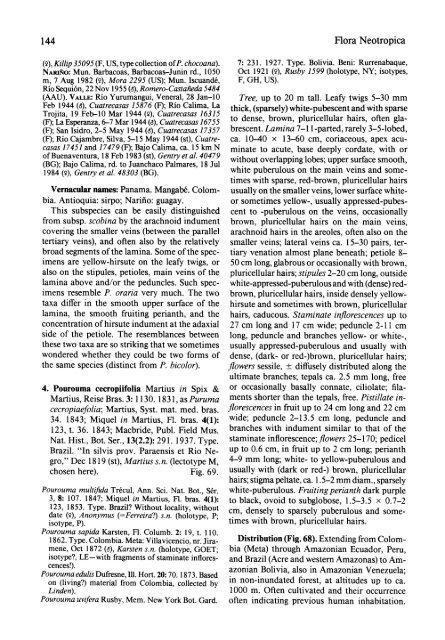Cecropiaceae: Coussapoa and Pourouma, with an ... - CNCFlora
Cecropiaceae: Coussapoa and Pourouma, with an ... - CNCFlora
Cecropiaceae: Coussapoa and Pourouma, with an ... - CNCFlora
You also want an ePaper? Increase the reach of your titles
YUMPU automatically turns print PDFs into web optimized ePapers that Google loves.
144 Flora Neotropica<br />
(9), Killip 35095 (F, US, type collection ofP. choco<strong>an</strong>a). 7: 231. 1927. Type. Bolivia. Beni: Rurrenabaque,<br />
NARIMO: Mun. Barbacoas, Barbacoas-Junin rd., 1050 Oct 1921 (9), Rusby 1599 (holotype, NY; isotypes,<br />
m, 7 Aug 1982 (9), Mora 2295 (US); Mun. Iscu<strong><strong>an</strong>d</strong>e, F, GH, US).<br />
Rio Sequi6n, 22 Nov 1955 (d), Romero-Cast<strong>an</strong>eda 5484<br />
(AAU). VALLE: Rio Yurum<strong>an</strong>gui, Veneral, 28 J<strong>an</strong>-10 Tree, up to 20 m tall. Leafy twigs 5-30 mm<br />
Feb 1944 (a), Cuatrecasas 15876 (F); Rio Calima, La<br />
Trojita, 19 Feb-10 Mar 1944 (2), Cuatrecasas 16315<br />
thick, (sparsely) white-pubescent <strong><strong>an</strong>d</strong> <strong>with</strong> sparse<br />
(F); La Esper<strong>an</strong>za, 6-7 Mar 1944 (d), Cuatrecasas 16755<br />
to dense, brown, pluricellular hairs, often gla-<br />
(F); S<strong>an</strong> Isidro, 2-5 May 1944 (8), Cuatrecasas 17357 brescent. Lamina 7-1 1-parted, rarely 3-5-lobed,<br />
(F); Rio Cajambre, Silva, 5-15 May 1944 (st), Cuatre- ca. 10-40 x 13-60 cm, coriaceous, apex acucasas<br />
17451 <strong><strong>an</strong>d</strong> 17479 (F); Bajo Calima, ca. 15 km N minate to acute, base deeply cordate, <strong>with</strong> or<br />
of Buenaventura, 18 Feb 1983 (st), Gentry et al. 40479 <strong>with</strong>out<br />
(BG); Bajo Calima, rd. to Ju<strong>an</strong>chaco Palmares, 18 Jul overlapping lobes; upper surface smooth,<br />
1984 (2), Gentry et al. 48303 (BG).<br />
white puberulous on the main veins <strong><strong>an</strong>d</strong> sometimes<br />
<strong>with</strong> sparse, red-brown, pluricellular hairs<br />
Vernacular names: P<strong>an</strong>ama. M<strong>an</strong>gabe. Colom- usually on the smaller veins, lower surface whitebia.<br />
Antioquia: sirpo; Nariiio: guagay. or sometimes yellow-, usually appressed-pubes-<br />
This subspecies c<strong>an</strong> be easily distinguished cent to -puberulous on the veins, occasionally<br />
from subsp. scobina by the arachnoid indument brown, pluricellular hairs on the main veins,<br />
covering the smaller veins (between the parallel arachnoid hairs in the areoles, often also on the<br />
tertiary veins), <strong><strong>an</strong>d</strong> often also by the relatively smaller veins; lateral veins ca. 15-30 pairs, terbroad<br />
segments of the lamina. Some of the spec- tiary venation almost pl<strong>an</strong>e beneath; petiole 8-<br />
imens are yellow-hirsute on the leafy twigs, or 50 cm long, glabrous or occasionally <strong>with</strong> brown,<br />
also on the stipules, petioles, main veins of the pluricellular hairs; stipules 2-20 cm long, outside<br />
lamina above <strong><strong>an</strong>d</strong>/or the peduncles. Such spec- white-appressed-puberulous <strong><strong>an</strong>d</strong> <strong>with</strong> (dense) redimens<br />
resemble P. oraria very much. The two brown, pluricellular hairs, inside densely yellowtaxa<br />
differ in the smooth upper surface of the hirsute <strong><strong>an</strong>d</strong> sometimes <strong>with</strong> brown, pluricellular<br />
lamina, the smooth fruiting peri<strong>an</strong>th, <strong><strong>an</strong>d</strong> the hairs, caducous. Staminate inflorescences up to<br />
concentration of hirsute indument at the adaxial 27 cm long <strong><strong>an</strong>d</strong> 17 cm wide; peduncle 2-11 cm<br />
side of the petiole. The resembl<strong>an</strong>ces between long, peduncle <strong><strong>an</strong>d</strong> br<strong>an</strong>ches yellow- or white-,<br />
these two taxa are so striking that we sometimes usually appressed-puberulous <strong><strong>an</strong>d</strong> usually <strong>with</strong><br />
wondered whether they could be two forms of dense, (dark- or red-)brown, pluricellular hairs;<br />
the same species (distinct from P. bicolor). flowers sessile, ? diffusely distributed along the<br />
ultimate br<strong>an</strong>ches; tepals ca. 2.5 mm long, free<br />
4. <strong>Pourouma</strong> cecropiifolia Martius in Spix & or occasionally basally connate, ciliolate; fila-<br />
Martius, Reise Bras. 3:1130. 1831, as Puruma ments shorter th<strong>an</strong> the tepals, free. Pistillate incecropiaefolia;<br />
Martius, Syst. mat. med. bras. florescences in fruit up to 24 cm long <strong><strong>an</strong>d</strong> 22 cm<br />
34. 1843; Miquel in Martius, Fl. bras. 4(1): wide; peduncle 2-13.5 cm long, peduncle <strong><strong>an</strong>d</strong><br />
123, t. 36. 1843; Macbride, Publ. Field Mus. br<strong>an</strong>ches <strong>with</strong> indument similar to that of the<br />
Nat. Hist., Bot. Ser., 13(2.2): 291. 1937. Type.<br />
staminate inflorescence; flowers 25-170; pedicel<br />
Brazil. "In silvis prov. Paraensis et Rio Ne- up to 0.6 cm, in fruit up to 2 cm long; peri<strong>an</strong>th<br />
gro," Dec 1819 (st), Martius s. n. (lectotype M,<br />
4-9 mm long; white- to yellow-puberulous <strong><strong>an</strong>d</strong><br />
chosen here). Fig. 69. usually <strong>with</strong> (dark or red-) brown, pluricellular<br />
hairs; stigma peltate, ca. 1.5-2 mm diam., sparsely<br />
white-puberulous. Fruiting peri<strong>an</strong>th dark purple<br />
to black, ovoid to subglobose, 1.5-3.5 x 0.7-2<br />
cm, densely to sparsely puberulous <strong><strong>an</strong>d</strong> sometimes<br />
<strong>with</strong> brown, pluricellular hairs.<br />
<strong>Pourouma</strong> multifida Trecul, Ann. Sci. Nat. Bot., Ser.<br />
3, 8: 107. 1847; Miquel in Martius, Fl. bras. 4(1):<br />
123, 1853. Type. Brazil? Without locality, <strong>with</strong>out<br />
date (9), Anonymus (=Ferreira?) s.n. (holotype, P;<br />
isotype, P).<br />
<strong>Pourouma</strong> sapida Karsten, Fl. Columb. 2: 19, t. 110.<br />
1862. Type. Colombia. Meta: Villavicencio, nr. Jiramene,<br />
Oct 1872 (a), Karsten s.n. (holotype, GOET;<br />
isotype?, LE-<strong>with</strong> fragments of staminate inflorescences!).<br />
<strong>Pourouma</strong> edulis Dufresne, Ill. Hort. 20: 70. 1873. Based<br />
on (living?) material from Colombia, collected by<br />
Linden).<br />
<strong>Pourouma</strong> uvifera Rusby, Mem. New York Bot. Gard.<br />
Distribution (Fig. 68). Extending from Colombia<br />
(Meta) through Amazoni<strong>an</strong> Ecuador, Peru,<br />
<strong><strong>an</strong>d</strong> Brazil (Acre <strong><strong>an</strong>d</strong> western Amazonas) to Amazoni<strong>an</strong><br />
Bolivia, also in Amazoni<strong>an</strong> Venezuela;<br />
in non-inundated forest, at altitudes up to ca.<br />
1000 m. Often cultivated <strong><strong>an</strong>d</strong> their occurrence<br />
often indicating previous hum<strong>an</strong> inhabitation.
















